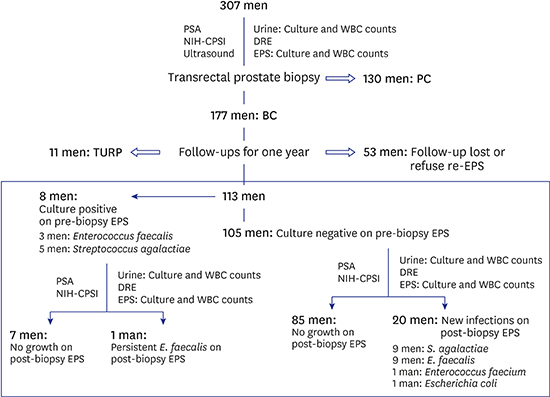1. Wagenlehner FM, Pilatz A, Waliszewski P, Weidner W, Johansen TE. Reducing infection rates after prostate biopsy. Nat Rev Urol. 2014; 11(2):80–86.

2. Roberts MJ, Bennett HY, Harris PN, Holmes M, Grummet J, Naber K, et al. Prostate biopsy-related infection:a systematic review of risk factors,prevention strategies, and management approaches. Urology. 2017; 104:11–21.
3. Hwang EC, Yu HS, Jung SI, Kwon DD, Lee SJ, Kim TH, et al. Infectious complications after prostate biopsy: a prospective multicenter prostate biopsy study. Urogenit Tract Infect. 2016; 11(1):17–24.

4. Campeggi A, Ouzaid I, Xylinas E, Lesprit P, Hoznek A, Vordos D, et al. Acute bacterial prostatitis after transrectal ultrasound-guided prostate biopsy: epidemiological, bacteria and treatment patterns from a 4-year prospective study. Int J Urol. 2014; 21(2):152–155.

5. Gaylis F, Nasseri R, Fink L, Calabrese R, Dato P, Cohen E. Prostate biopsy complications: a dual analysis. Urology. 2016; 93:135–140.

6. Rosario DJ, Lane JA, Metcalfe C, Donovan JL, Doble A, Goodwin L, et al. Short term outcomes of prostate biopsy in men tested for cancer by prostate specific antigen: prospective evaluation within ProtecT study. BMJ. 2012; 344:d7894.

7. Cussans A, Somani BK, Basarab A, Dudderidge TJ. The role of targeted prophylactic antimicrobial therapy before transrectal ultrasonography-guided prostate biopsy in reducing infection rates: a systematic review. BJU Int. 2016; 117(5):725–731.

8. Kim SJ, Kim SI, Ahn HS, Choi JB, Kim YS, Kim SJ. Risk factors for acute prostatitis after transrectal biopsy of the prostate. Korean J Urol. 2010; 51(6):426–430.

9. Yoon BI, Han DS, Ha US, Lee SJ, Sohn DW, Kim HW, et al. Clinical courses following acute bacterial prostatitis. Prostate Int. 2013; 1(2):89–93.

10. Seo Y, Lee G. Antimicrobial resistance pattern in Enterococcus faecalis strains isolated from expressed prostatic secretions of patients with chronic bacterial prostatitis. Korean J Urol. 2013; 54(7):477–481.
11. Park H, Sim SM, Lee G. The presence of Chlamydia is associated with increased leukocyte counts and pain severity in men with chronic pelvic pain syndrome. Urology. 2015; 85(3):574–579.

12. Song J, Park H, Lee G. Contribution of genetic variation rs266882 to prostate-specific antigen levels in healthy controls with serum PSA below 2.0 ng/ml. Biochem Genet. 2013; 51(3-4):264–274.
13. Nickel JC, Stephens A, Landis JR, Chen J, Mullins C, van Bokhoven A, et al. Search for microorganisms in men with urologic chronic pelvic pain syndrome: a culture-independent analysis in the MAPP research network. J Urol. 2015; 194(1):127–135.

14. Inci M, Davarci M, Inci M, Motor S, Yalcinkaya FR, Nacar E, et al. Anti-inflammatory and antioxidant activity of thymoquinone in a rat model of acute bacterial prostatitis. Hum Exp Toxicol. 2013; 32(4):354–361.

15. Gamé X, Vincendeau S, Palascak R, Milcent S, Fournier R, Houlgatte A. Total and free serum prostate specific antigen levels during the first month of acute prostatitis. Eur Urol. 2003; 43(6):702–705.

16. Kim JW, Oh MM, Bae JH, Kang SH, Park HS, Moon DG. Clinical and microbiological characteristics of spontaneous acute prostatitis and transrectal prostate biopsy-related acute prostatitis: is transrectal prostate biopsy-related acute prostatitis a distinct acute prostatitis category? J Infect Chemother. 2015; 21(6):434–437.
17. Yamamoto M, Hibi H, Miyake K. Prostate-specific antigen levels in acute and chronic bacterial prostatitis. Hinyokika Kiyo. 1993; 39(5):445–449.
18. Verani JR, McGee L, Schrag SJ; Division of Bacterial Diseases, National Center for Immunization and Respiratory Diseases, Centers for Disease Control and Prevention (CDC). Prevention of perinatal group B streptococcal disease--revised guidelines from CDC, 2010. MMWR Recomm Rep. 2010; 59:RR-10. 1–36.
19. Agudelo Higuita NI, Huycke MM. Enterococcal disease, epidemiology, and implications for treatment. In : Gilmore MS, Clewell DB, Ike Y, Shankar N, editors. Enterococci: from Commensals to Leading Causes of Drug Resistant Infection [Internet]. Boston, MA: Massachusetts Eye and Ear Infirmary;2014.
http://www.ncbi.nlm.nih.gov/books/NBK190429/.
20. Naber KG, Roscher K, Botto H, Schaefer V. Oral levofloxacin 500 mg once daily in the treatment of chronic bacterial prostatitis. Int J Antimicrob Agents. 2008; 32(2):145–153.
21. Lee G, Romih R, Zupančič D. Cystitis: from urothelial cell biology to clinical applications. Biomed Res Int. 2014; 2014:473536.

22. Martin GL, Nunez RN, Humphreys MD, Martin AD, Ferrigni RG, Andrews PE, et al. Interval from prostate biopsy to robot-assisted radical prostatectomy: effects on perioperative outcomes. BJU Int. 2009; 104(11):1734–1737.

23. Capitanio U, Pfister D, Emberton M. Repeat prostate biopsy: rationale, indications, and strategies. Eur Urol Focus. 2015; 1(2):127–136.

24. Battikhi MN, Ismail H, Battikhi Q. Effects of chronic bacterial prostatitis on prostate specific antigen levels total and free in patients with benign prostatic hyperplasia and prostate cancer. Int Urol Nephrol. 2006; 38(1):21–26.

25. Litwin MS, McNaughton-Collins M, Fowler FJ Jr, Nickel JC, Calhoun EA, Pontari MA, et al. The National Institutes of Health chronic prostatitis symptom index: development and validation of a new outcome measure. Chronic Prostatitis Collaborative Research Network. J Urol. 1999; 162(2):369–375.
26. Wagenlehner FM, Pilatz A, Bschleipfer T, Diemer T, Linn T, Meinhardt A, et al. Bacterial prostatitis. World J Urol. 2013; 31(4):711–716.

27. Krieger JN, Ross SO, Limaye AP, Riley DE. Inconsistent localization of gram-positive bacteria to prostate-specific specimens from patients with chronic prostatitis. Urology. 2005; 66(4):721–725.

28. Bundrick W, Heron SP, Ray P, Schiff WM, Tennenberg AM, Wiesinger BA, et al. Levofloxacin versus ciprofloxacin in the treatment of chronic bacterial prostatitis: a randomized double-blind multicenter study. Urology. 2003; 62(3):537–541.

29. Lee GH, Lee JH. Clinical significance of incidental prostatic fluorine-18-fluorodeoxyglucose uptake in the diagnosis of infectious prostatitis in adult males. Nucl Med Commun. 2017; 38(6):523–528.









 PDF
PDF Citation
Citation Print
Print




 XML Download
XML Download